Share
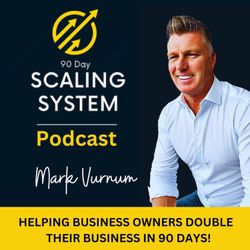
90 Day Scaling System Podcast
Double Your Business In The Next 90 Days Using The FOUR Hidden Scale Levers ALREADY In Your Business..
Latest episode
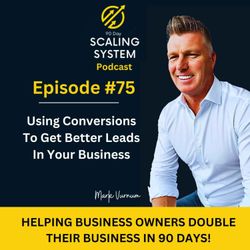
75. E75: Using Conversions To Get Better Leads In Your Business
04:38||Season 1, Ep. 75The Power of Conversion Ads in Meta's PlatformConversion ads are the heavy hitters in digital marketing. Let's explore their unique advantages:Action-Oriented: These ads are specifically designed to encourage users to take concrete actions, such as purchases or sign-ups.Measurable Results: Conversion ads provide tangible metrics that clearly define return on investment (ROI).Targeting with Intent: By focusing on users predisposed to convert, these ads optimize the efficiency of your ad spend.Leveraging Conversion Ads for Optimal PerformanceMaximizing the effectiveness of conversion ads requires a strategic approach:Clearly Define Conversion GoalsIdentify Desired Actions: Be clear about the actions you want users to take, and set those as your conversion goals.Set Up Conversion Tracking: Use Meta's pixel or comparable tracking solutions to measure ad success accurately.Craft Strategic Ad ContentAlign Creatives with Conversions: Every aspect of your ad should drive users towards the desired action.Compelling Copy and CTA: Write persuasive copy with a clear call-to-action that speaks to your audience's needs.Optimize for Targeted AudiencesUse High-Intent Targeting Options: Use Meta's advanced targeting to reach prospects most likely to convert.Retarget Engaged Users: Focus on individuals who have previously interacted with your brand but haven't converted yet.Test and RefineA/B Testing: Continuously test various ad components to identify those that yield the best conversion rates.Analyze and Adjust: Leverage conversion tracking data to continually refine your ad strategy.The 90-Day Conversion Ad Mastery PlanHere's a systematic plan to boost your conversion ad strategy within 90 days:Phase 1: Setup and Launch (Days 1-30)Define Your Objectives: Establish clear, measurable conversion targets.Create and Implement: Build your ads and ensure comprehensive tracking with Meta's pixel.Soft Launch: Begin with a modest budget to gather preliminary data and avoid overspending.Phase 2: Data Collection and Analysis (Days 31-60)Monitor Performance: Closely watch conversion metrics to identify top-performing ads.Optimize Ads: Refine your ads based on data insights, adjusting creatives, targeting, and CTAs as necessary.Adjust Budgets: Increase spending on your most successful ads.Phase 3: Scaling and Refinement (Days 61-90)Expand Audiences: Extend your reach by targeting new potential customers informed by your successful ad data.Test New Creatives: Introduce fresh ad content to prevent ad fatigue and captivate additional users.Automate and Scale: Apply automated rules for bidding and budgeting to optimize conversion rates.
More episodes
View all episodes

74. E74: Scaling Using Meta Ads - Don't Case Leads... Do This Instead
04:47||Season 1, Ep. 74Why Meta Ads Can Scale Your Business.. But Not Just Get You Leads..The digital marketing landscape is evolving, and Meta Ads are at the forefront of this transformation. They can turn the tide from lead chasing to appointment setting:Highly Targeted Audiences: Reach those most likely to book thanks to Meta’s robust targeting capabilities.Intent-Focused Campaigns: Create campaigns aimed at getting bookings, not just leads.Engagement Tracking: Use Meta's analytics to track how users interact with your ads and optimize for better appointment conversion rates.Crafting Meta Ad Campaigns for AppointmentsHere’s a strategic approach to crafting Meta Ads campaigns:Define Your ObjectiveClear Call-To-Action (CTA): Your ad must focus on one thing - booking an appointment.Value Proposition: Highlight the unique benefits of an appointment with your business.Target the Right AudienceCustomer Personas: Use detailed personas for precise targeting.Lookalike Audiences: Find new prospects similar to your best clients with Meta's lookalike audiences.Design Engaging CreativesVisual Appeal: Use high-quality visuals to capture and keep attention.Compelling Copy: Address the viewer’s needs and how your solution fits.Optimize the Booking ExperienceFrictionless Flow: Make the journey from ad to appointment booking smooth.Mobile Optimization: Ensure the booking process is easy on mobile devices.The 90 Day Meta Ads Appointment-Scaling PlanLet’s outline a 90-day plan to grow your business through Meta Ads focused on appointment bookings:Phase 1: Campaign Foundation (Days 1-30)Market Research: Determine where your ideal clients are on Meta platforms.Ad Development: Craft ads that resonate with your audience.Booking System Integration: Implement a booking system that’s reliable and user-friendly.Phase 2: Campaign Launch and Optimization (Days 31-60)Soft Launch: Begin with a modest budget to gather data.Analyse and Adjust: Refine your ads using Meta’s analytics for better performance.Scale Budget: Increase spending on ads that are performing well.Phase 3: Refinement and Expansion (Days 61-90)Data-Driven Decisions: Adjust your strategy based on the data collected.A/B Testing: Test different ad elements to discover what works best.Expand Reach: Use successful data patterns to target new audiences.Measuring SuccessTo evaluate the effectiveness of your Meta Ads campaigns:Appointment Rates: Track the number of appointments from the ads.Conversion Rates: Measure the percentage of ad viewers who book.Customer Acquisition Cost (CAC): Assess the cost to acquire a customer via your ads.Return on Ad Spend (ROAS): Determine the revenue from appointments relative to ad expenditure.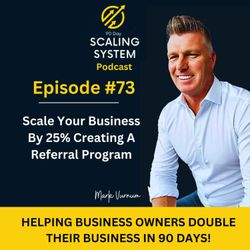
73. E73: Scale Your Business By 25% Creating A Referral Program
04:47||Season 1, Ep. 73The Efficacy of Referral ProgrammesReferral programmes harness the power of your existing customers' networks. They're effective because:Augmented Credibility: Personal recommendations carry more weight than traditional ads.Cost Efficiency: High return on investment, with less expenditure compared to other marketing channels.Superior Client Fit: Referred clients often have a better fit with your service or product, leading to improved retention.Constructing an Irresistible Referral ProgrammeTo build a referral program that turns your customers into advocates, consider the following steps:Understanding Your ClienteleIdentify Your Champions: Pinpoint your most enthusiastic customers and approach them first.Client Understanding: Use surveys to learn what rewards your customers find most enticing.Programme DesignAlluring Incentives: Offer rewards that genuinely motivate your customers.Ease of Use: Ensure the referral process is straightforward and user-friendly.Transparent Communication: Clearly explain how the program works and what the benefits are.Promoting Your ProgrammeInauguration Event: Kick off your program with an event that generates buzz.Consistent Reminders: Use newsletters and social media to keep the program top-of-mind.Tales of Success: Share success stories to illustrate the program's benefits.The 90 Day Roadmap to Expand Your Client BaseHere's how you can roll out a successful referral program in 90 days:Phase 1: Programme Development (Days 1-30)Establish Clear Objectives: Define what a 25% increase means in numbers.Devise the Offer: Select the incentives for both the referrer and referee.Construct the Framework: Set up a system to track and manage the referrals and rewards.Phase 2: Programme Initiation (Days 31-60)Publicise the Programme: Introduce your clients to the program through various channels.Engage Advocates: Get your key customers on board to start spreading the word.Solicit Feedback: Listen to initial responses and be ready to adjust as needed.Phase 3: Programme Refinement (Days 61-90)Data Scrutiny: Analyze the performance and identify trends.Refine and Enhance: Modify the program based on feedback and data.Broaden Participation: Encourage more clients to participate and continue to promote the program.Measuring Programme TriumphTrack these metrics to ensure success:Referral Frequency: Count how often clients refer others.Conversion Success: Track the rate at which referrals become paying clients.Client Continuity: Assess the longevity of referred clients against others.Return on Investment: Weigh the program's costs against the lifetime value of new clients.ConclusionA well-crafted referral program can significantly expand your client base. By strategically designing and implementing the program, that 25% increase is within reach.
72. E72: Scale Your Business Entering New Geo-Markets
04:48||Season 1, Ep. 72Understanding the Terrain of New MarketsBefore diving into a new market, it's imperative to grasp the full scope of what you're stepping into:Cultural Nuances: Recognise the local customs and behaviours that impact business transactions and consumer engagement.Regulatory Framework: Navigate the laws and regulations to ensure your business operations are compliant.Market Demand: Validate the need for your product or service through comprehensive market research.Competition Analysis: Understand your competition to pinpoint your unique selling proposition.The 90 Day Blueprint for Market ExpansionLet's break down your journey into a 90-day action plan:Phase 1: Research and Planning (Days 1-30)In-Depth Market Research: Collect and analyse data to fine-tune your market entry strategy.Strategic Partnerships: Forge connections with local entities that can provide insights and support.Product/Service Adaptation: Tailor your offerings to align with local preferences and requirements.Entry Strategy Formulation: Choose the best mode of entry, from franchising to joint ventures or direct exports.Phase 2: Building Foundations (Days 31-60)Legal Setup: Establish a legal footprint, whether through a subsidiary, partnership, or other structures.Operational Infrastructure: Construct your supply chain and distribution networks.Local Talent Acquisition: Recruit professionals with local expertise to navigate cultural and market nuances.Marketing Strategies: Craft marketing initiatives that resonate with your target demographic.Phase 3: Launch and Scale (Days 61-90)Soft Launch: Initiate a controlled launch to refine your strategy based on real-world feedback.Grand Opening: Create buzz with a significant launch event to announce your presence.Performance Monitoring: Implement systems to track and analyze your expansion's success.Scale and Optimize: Use collected data to expand your reach and enhance operational efficiency.Tactical Insights for Market ExpansionIn our masterclass, we'll cover essential tactics for a successful market expansion:Navigating Cultural Differences: Gain insights into bridging cultural divides in business practices.Building a Robust Local Network: Establish connections with local influencers and organisations.Risk Management: Anticipate potential challenges and prepare strategies to mitigate them.Leveraging Technology: Employ tech solutions to improve operations and customer experiences.Measuring Success in New FrontiersWe'll explore how to measure your market expansion success through:Sales and Revenue Growth: Keep a close eye on financial performance indicators.Market Share Analysis: Evaluate how much of the new market you're capturing over time.Brand Awareness Metrics: Monitor how your brand is resonating with the new audience.Customer Satisfaction: Collect and act on customer feedback to meet the local market's needs.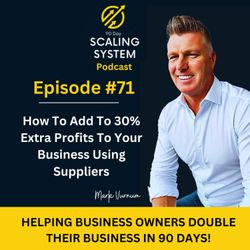
71. E71: How To Add Upto 30% Extra Profits To Your Business Using Suppliers
03:57||Season 1, Ep. 71The Vital Role of Supplier Negotiations in Business ExpansionNegotiating with suppliers is more than a cost-cutting exercise; it's a strategic initiative that can redefine your financial landscape:Immediate Margin Improvement: Cost reductions gained through negotiation can lead to significant enhancements in profit margins immediately.Sustainable Competitive Advantage: Savings from negotiations can provide the flexibility needed for innovation, product improvement, and market repositioning.Fostering Strategic Alliances: Viewing suppliers as partners, not just vendors, can lead to preferential pricing and terms over time.A Strategic Approach to Supplier NegotiationsFor effective supplier negotiations, you need a plan that's thorough and flexible. Here's a structured approach:In-Depth Market Analysis: Equip yourself with comprehensive knowledge of the supplier's market, competition, and pricing tactics. A complete understanding gives you leverage in talks.Mutual Benefits Identification: Look for areas where you and the supplier can both gain from the arrangement, such as long-term contracts, bulk orders, or joint marketing initiatives.Value-Added Partnership Communication: Emphasise that your interest in negotiation is not solely price-driven but aimed at establishing a beneficial partnership.Mastering Negotiation Techniques for Maximised Cost SavingsTo negotiate effectively, employ these tactics:Volume Leveraging: Offer commitments to larger volumes for cost reductions, but carefully avoid excess that leads to waste.Developing Alternative Options: Having a backup gives you strength in negotiations. Suppliers are likelier to provide better terms if they know you have other options.Assembling a Skilled Negotiation Team: Create a team with diverse expertise—technical, commercial, and relational—to support a holistic negotiation strategy.Success Metrics for Supplier NegotiationIt's vital to track the impact of your negotiation efforts:Quantifiable Cost Reductions: Measure the direct savings as a percentage in relation to pre-negotiation costs.Quality and Service Maintenance: Ensure cost savings don't compromise the quality or service of the supplies received.Supplier Performance Tracking: Monitor the supplier's adherence to agreed terms, including delivery schedules, quality standards, and service levels.Learning from Successful Negotiation Case StudiesDraw inspiration from negotiation success stories:Retail Giants: Analyse how major retailers use their bulk-purchase power to negotiate better rates without sacrificing quality or delivery times.Manufacturing Pioneers: Look into how leading manufacturers conduct supply chain negotiations to reduce material costs while upholding stringent quality standards.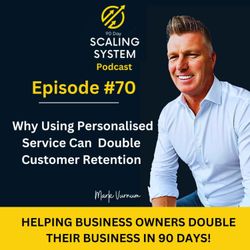
70. E70: Why Using Personalised Service Can Double Customer Retention
04:16||Season 1, Ep. 70The Critical Role of Personalisation in Customer RetentionPersonalisation is the heartbeat of a thriving customer relationship. By crafting individualised experiences, you can:Foster Deep Customer Loyalty: Personal connections lead to emotional loyalty, making customers more likely to stick with your brand.Skyrocket Customer Satisfaction: When you meet and exceed customer expectations with personalised service, satisfaction soars.Stand Out from the Crowd: In a sea of uniformity, personalized experiences are your brand's signature—distinct and memorable.Blueprint for Personalised Service ImplementationTo harness the power of personalisation and make it a cornerstone of your customer retention strategy, follow this blueprint:Leverage Customer Insights: Use data analytics to dissect customer preferences and behaviors, creating a foundation for tailored experiences.Segment and Conquer: Group your customers based on shared characteristics and customise your approach to resonate with each segment.Engage with Customised Communication: Address your customers by name and reference their past interactions, making every touchpoint feel exclusive and thought-out.Strategies for Scaling Personalised ServicesPersonalisation at scale is a balancing act, and here's how to master it:Embrace Automation and AI: Smart technology can personalise experiences on a large scale without losing the personal touch.Invest in Your Team: Train your staff to understand and execute personalised service. They're the front-line architects of your customer experience.Cultivate Continuous Feedback: Establish a feedback loop that captures customer reactions to personalized services and use it to refine your approach.Metrics to Measure Personalisation's Impact on RetentionTo validate your personalised service strategies, focus on these metrics:Monitor Retention Rates: Watch how these rates evolve as you implement personalised services.Assess Customer Lifetime Value (CLV): A rise in CLV can indicate that personalised experiences are encouraging customers to spend more over time.Evaluate Net Promoter Score (NPS): An increase in NPS suggests that personalisation is bolstering customer loyalty and the likelihood of referrals.Success Stories of Personalised Retention StrategiesGain inspiration from businesses that have mastered personalisation:E-Commerce Leaders: Analyse how companies like Amazon use browsing and purchasing data to create a customised shopping environment, resulting in impressive retention rates.Streaming Service Pioneers: Consider how Netflix's personalised recommendations keep viewers engaged and reduce subscriber churn.Conclusion: Crafting the Future of Retention with Personal TouchPersonalised service is not just a fleeting trend—it's the future of customer retention. Implement the strategies we've covered, and you'll be well on your way to scaling your business's success in under 90 days.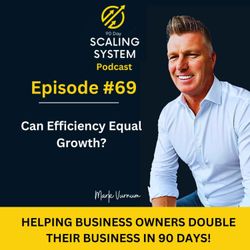
69. E69: Can You Scale Through Efficiency?
05:19||Season 1, Ep. 69The Far-Reaching Benefits of Operational Efficiency on RevenueOperational efficiency is not a one-off project; it's a strategic commitment that touches every aspect of your business. Here’s why it should be at the forefront of your growth strategy:Resource Optimization: When you streamline your operations, you ensure that every asset, every employee, and every process is optimized for peak performance, which in turn maximizes your resource utilization and investment.Customer Satisfaction and Retention: Efficient operations are the backbone of a superior customer experience. They lead to faster service, higher quality products, and increased customer satisfaction, which are pivotal in driving repeat business and customer loyalty.Agility in the Market: An operationally efficient business can respond to market changes with unmatched speed and dexterity, allowing it to stay ahead of competitors and capitalize on emerging opportunities with unparalleled efficiency.Strategies for Operational Changes to Scale RevenueLet's explore actionable strategies that can significantly enhance your revenue through operational excellence:Adoption of Lean Principles: Embrace lean methodologies to systematically identify and eradicate non-value-adding processes, thereby streamlining your operations from back-end activities right through to customer delivery.Automation for Consistency and Efficiency: Leverage cutting-edge automation technologies to take over mundane and repetitive tasks. This not only boosts consistency and accuracy but also allows your talented team to direct their focus toward strategic, revenue-generating activities.Data-Driven Decision Making: Cultivate a robust analytics framework to make smarter, evidence-based decisions that optimize operations and effectively target the most profitable customer segments and market opportunities.Creating Customer-Centric Operations to Drive RevenueRefine your operations with a laser focus on the customer:Robust Customer Feedback Systems: Implement comprehensive systems to solicit, analyze, and act on customer feedback, ensuring that your services and products are constantly evolving to meet and exceed customer expectations.Personalization of Services: Utilize rich customer data to create customized and personalized service offerings. Personalization can differentiate your brand and allow you to command premium prices, thereby increasing revenue and customer loyalty.Streamlined and Dependable Delivery Systems: Develop and maintain delivery systems that are both streamlined for efficiency and dependable for timeliness, reducing errors and enhancing customer trust in your brand.